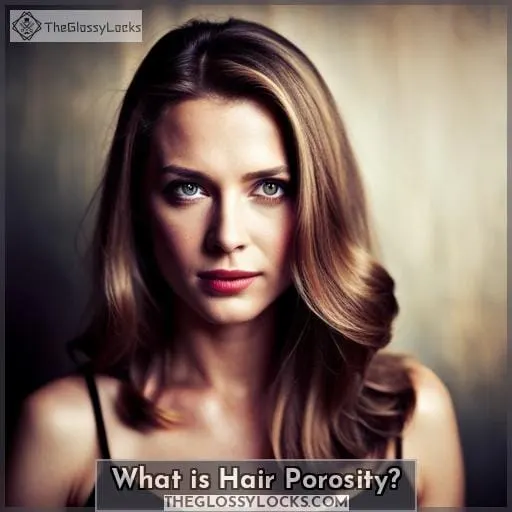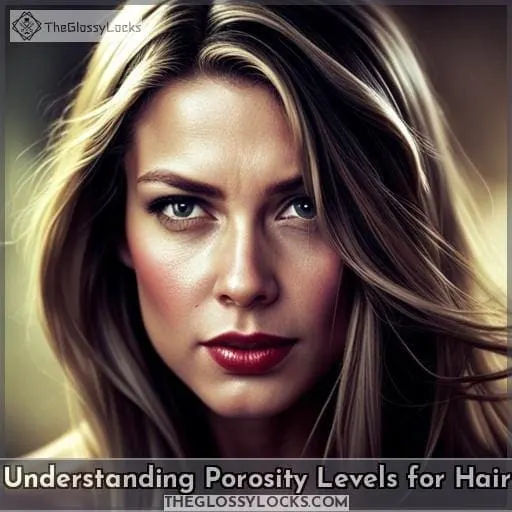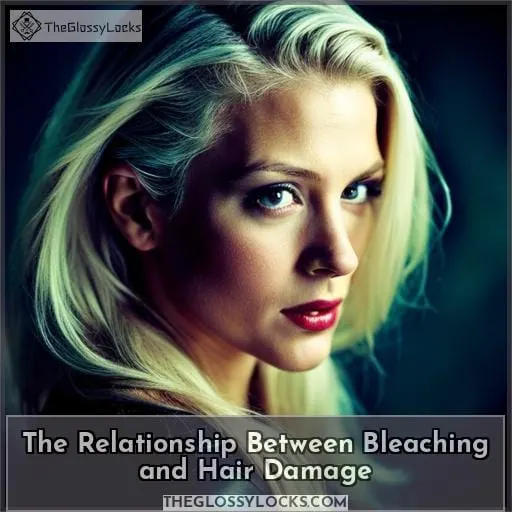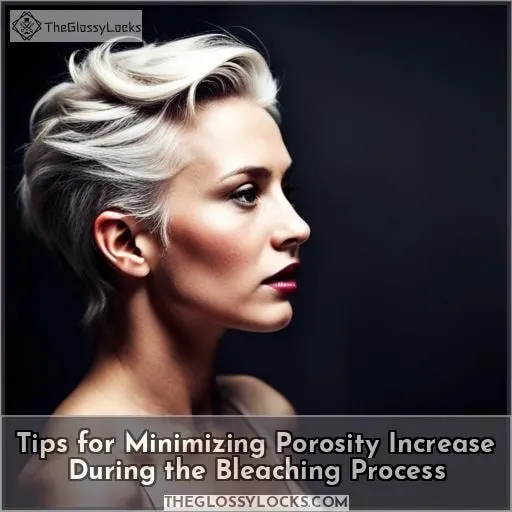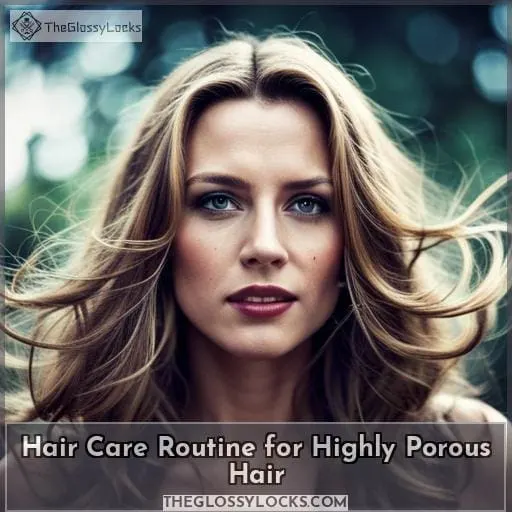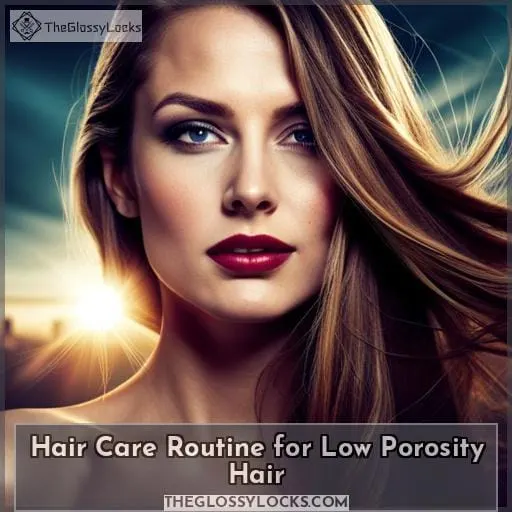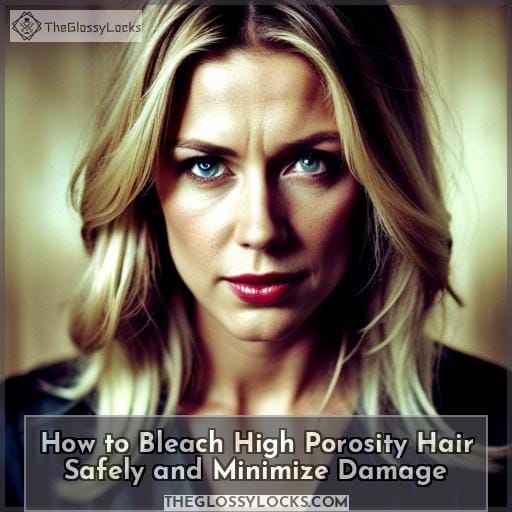This site is supported by our readers. We may earn a commission, at no cost to you, if you purchase through links.
 Are you curious about how bleaching your hair could impact its porosity? If so, you’re not alone. Whether it’s because of a desire to switch up their look or an attempt to correct overly damaged hair, many people are left wondering if they should take the plunge and bleach their tresses.
Are you curious about how bleaching your hair could impact its porosity? If so, you’re not alone. Whether it’s because of a desire to switch up their look or an attempt to correct overly damaged hair, many people are left wondering if they should take the plunge and bleach their tresses.
The truth is that bleaching does indeed increase porosity levels in the hair; however, there are ways to minimize this effect while still achieving a beautiful color change. In this article, we will discuss everything from understanding different types of porosity levels for hair and how bleaching affects them, as well as tips on minimizing damage during the process.
We’ll also explore which type of haircare routine would be best suited for both highly porous and low porous locks after being exposed to bleach! So prepare yourself – let’s dive into uncovering whether or not bleaching really increases your hair’s porosity level!
Table Of Contents
- Key Takeaways
- What is Hair Porosity?
- Understanding Porosity Levels for Hair
- Does Bleaching Hair Increase Porosity?
- The Relationship Between Bleaching and Hair Damage
- Tips for Minimizing Porosity Increase During the Bleaching Process
- Hair Care Routine for Highly Porous Hair
- Hair Care Routine for Low Porosity Hair
- Can Bleached High Porosity Hair Hold Color Well?
- Difficulties of Dyeing Low Porosity Hair
- How to Bleach High Porosity Hair Safely and Minimize Damage
- Conclusion
Key Takeaways
- Bleaching hair increases hair porosity.
- High porosity hair absorbs too much moisture.
- Low porosity hair struggles to absorb moisture.
- Managing bleached hair porosity requires specialized products and treatments.
What is Hair Porosity?
Hair porosity is like a window into your hair’s health; understanding it can help you craft the perfect care routine for luscious locks. Porosity testing helps identify how well your hair absorbs and retains moisture, as this varies from one person to another.
This knowledge is invaluable since all forms of damage, such as excessive heat styling, UV exposure, or bleaching, can make the cuticles more porous and affect moisture management.
Low porosity hair takes a long time to dry and products tend to sit on top of it. Medium porosity hair floats briefly in water. High porosity hair sinks quickly. High-porosity strands require careful attention, as they’re much more prone to breakage due to their raised cuticles that absorb too much or not enough moisture, leading to dryness and frizziness.
Bleaching may increase porosity by changing the structure of the hair shaft, so use caution when lightening – always research products beforehand! With proper nourishment using hydrating shampoos/conditioners along with deep conditioning treatments tailored specifically for highly porous tresses, you can keep them looking healthy despite any risks associated with bleaching and other damaging activities such as dyeing or heat styling.
Knowing how your own hair reacts in different situations allows you to take control over its health, so start exploring today!
Understanding Porosity Levels for Hair
Understanding your hair porosity level is essential in order to ensure proper moisture management and damage prevention. To determine your hair porosity, you can perform a simple water test: if the strand of hair floats briefly before sinking, then it has medium porosity and is ideal.
However, if it sinks quickly or fails to float at all, then the strands have either high or low porosity, respectively.
High-porosity strands are prone to dryness due to their raised cuticles, which causes them to absorb more moisture than necessary. On the other hand, low-porosity locks become weighed down with too much product buildup as they lack enough open cuticles for effective absorption.
Therefore, when bleaching one’s mane, caution should be taken as this activity could increase one’s existing levels of porosity by opening up the already exposed cuticles. This can result in excessive hydration retention or loss, depending on the type of porosity present beforehand.
Additionally, products like Davines Nourishing Extreme Damage Repair Set and L’Oréal Professionnel Serie Expert Inforcer Duo specifically target breakage and split ends, which are often caused by high-porosity hair.
Does Bleaching Hair Increase Porosity?
It is no secret that bleaching your hair can leave it looking and feeling dry, brittle, and damaged. But what actually happens to the cuticles of the hair when you bleach them? Does this process affect porosity levels? Understanding how bleaching affects porosity levels is key in order to properly care for your bleached locks.
The Impact of Bleaching on Hair Cuticles
When bleaching your locks, it’s essential to consider how the process can affect hair cuticles. This is especially true if you’re aiming for a dramatic color change. The bleaching process impacts porosity levels.
Open hair cuticles are more prone to damage and moisture absorption or loss. Therefore, understanding porosity types before engaging in any chemical treatment is key for healthy-looking tresses.
High porosity is one of the most common side effects caused by bleaching. However, with proper care and nourishing products like Davines Nourishing Extreme Damage Repair Set or L’Oréal Professionnel Serie Expert Inforcer Duo, highly porous strands can be managed successfully without sacrificing their healthiness even after being subjected to strong chemicals such as those used in bleaching!
How Bleaching Affects Porosity Levels
You’ve likely noticed how bleaching your hair affects the porosity levels. Hair bleaching is a chemical process that can cause damage to the cuticles, leading to an increased absorption of moisture and therefore more porous hair.
Although it may be tempting, excessive heat styling and dyeing should be avoided in order to prevent further damage and increase of porosity level.
Additionally, avoid using hot tools too often on highly porous manes. This will help reduce breakage from occurring due to lack of adequate moisture in these fragile hairs! Taking care when bleach or color your tresses ensures that you won’t end up with overly dry locks down the line.
The Relationship Between Bleaching and Hair Damage
By bleaching your hair, you risk damaging and increasing its porosity. The aftermath of a bleaching session can leave the hair cuticles relaxed, leading to high porosity. This causes moisture absorption and loss, which leads to dryness, brittleness, and breakage.
To prevent damage from excessive bleach use, it’s essential to understand how different components interact with one another when caring for your hair health. Porosity management must be considered in order for proper styling options that will help maintain the integrity of the strands over time without causing further damage due to chemical treatments or heat styling tools, such as blow-dryers or flat irons found at higher temperature settings used more often than necessary on highly porous tresses.
With this knowledge comes an understanding that all forces acting upon damaged locks require delicate manipulation so as not to worsen existing conditions while attempting restoration measures needed for healthier-looking tresses overall.
Tips for Minimizing Porosity Increase During the Bleaching Process
Bleaching your hair is a process that can cause damage due to increased porosity. However, there are measures you can take to minimize the effects of this increase in porosity when bleaching, such as using a lower volume developer, applying Olaplex or similar bond repair treatments, and limiting the frequency of bleaching sessions.
By being mindful of these steps during the bleaching process, you’ll be able to achieve beautiful colored results without sacrificing too much hair health.
Using a Lower Volume Developer
To keep your hair healthy and minimize porosity rise, consider using a lower volume developer when bleaching.
- Minimizing breakage
- Strengthening cuticles
- Retaining moisture
- Avoiding dryness or frizziness. For best results, always use protective products to guard against further harm from heat styling tools or chemical treatments post-bleach session for ultimate hair care success!
Applying Olaplex or Similar Bond Repair Treatments
Smoothing split ends and protecting against further damage, applying Olaplex or similar bond repair treatments can help minimize porosity while bleaching. Olaplex helps rebuild broken disulphide bonds in the hair that are damaged during chemical processes like bleaching.
It also works to restore lost moisture and strength from previous heat styling or coloring services for healthier-looking locks.
Its benefits include reduced breakage, improved shine and softness, as well as enhanced color vibrancy when used prior to a dye service.
Limiting the Frequency of Bleaching Sessions
Limit the number of times you bleach your hair to minimize porosity increase. Hair bleaching has a direct impact on hair porosity, and limiting the frequency of sessions is key in controlling it.
- Using an Olaplex or similar bond repair treatment after each session.
- Keeping bleaching sessions at least 8 weeks apart.
- Refraining from using hot tools during that time period.
- Applying moisturizing products with SPF protection daily.
- Getting regular trims for split ends prevention and growth health preservation. Bleached hair needs special care to stay strong, vibrant, shiny—and porous!
Hair Care Routine for Highly Porous Hair
As you may know, bleaching hair can increase porosity and damage the cuticles. To minimize this effect, it is important to have an adequate hair care routine for highly porous hair. This includes using a hydrating shampoo and conditioner system, deep conditioning treatments, as well as applying heat protectant before styling with hot tools.
With these steps, your hair will be more manageable and less prone to breakage or split ends than without proper treatment.
Hydrating Shampoo and Conditioner System
For optimal hair hydration, using a moisturizing shampoo and conditioner system is key for high porosity hair. This helps to counter the effects of bleaching and other activities that open the cuticles, resulting in excessive moisture absorption.
A hydrating system can help prevent further damage from occurring while providing conditioning solutions for existing issues. Bleaching should always be done with caution as it has the potential to increase porosity levels.
The right combination of products will ensure lasting moisture benefits without compromising on style or quality – essential components when creating an effective hair care regimen that works best for you!
Deep Conditioning Treatments
To keep your hair healthy and hydrated, you should incorporate deep conditioning treatments into your routine. Moisturizing and nourishing products help maintain moisture retention while managing porosity levels to prevent damage caused by bleaching or dyeing.
An effective deep conditioning treatment can restore luster, add strength, reduce breakage, and improve overall hair health. Use a weekly mask that contains natural oils like argan oil for maximum benefit followed by a gentle sulfate-free shampoo to rinse away any product buildup without stripping the strands of necessary nutrients.
By focusing on moisture retention with regular deep conditioner treatments as part of your overall hair care regimen, you will see improved results in terms of texture and manageability.
Heat Protectant Usage
Protect your strands with a heat protectant and keep them looking salon-fresh for longer. Heat protectants help reduce hair damage from bleaching, curling, or straightening. They also provide essential moisture to highly porous hair cuticles in need of repair.
Benefits include preventing further porosity increase after bleaching and aiding in the retention of natural oils and moisture for healthier locks over time.
Here are some tips when using a heat protectant:
- Apply it evenly throughout damp hair before styling.
- Don’t overload as this can weigh down finer textures.
- Experiment on low temperatures to avoid damaging high porosity strands.
- Use leave-in treatments afterward for extra protection.
- Choose one that’s specifically designed for colored/processed hair.
Endeavor to find remedies tailored towards your unique needs!
Hair Care Routine for Low Porosity Hair
It is important to understand the porosity of your hair in order to create an effective and beneficial hair care routine. For individuals with low porosity, pre-poo treatments, heat conditioning, and water-based leave-in products are essential steps for keeping their tresses healthy.
Pre-Poo Treatment
Kickstart your hair care routine with a pre-poo treatment to keep moisture locked in and prevent damage. Regularly using one can help protect your locks from heat, color fading, breakage, and more.
This treatment coats the hair strand with essential oils that form a protective barrier for both low porosity or highly porous locks before the shampooing or bleaching process starts. Applying this type of product not only helps improve moisture retention but also aids in strengthening strands while providing extra protection against harsh chemicals used when bleaching hair.
Pre-poo treatments are key to maintaining healthy tresses after any sort of chemical process like color dyeing or lightening.
Heat During Conditioning
Slather your tresses with a heat-activated conditioner for an extra boost of moisture. Heat during conditioning is great for low porosity hair to help it retain more moisture and reduce damage from bleaching or other chemical treatments.
Use a blow dryer, steamer cap, or thermal heating cap – whatever method suits you best – but keep the temperature setting at medium heat to prevent damaging your strands.
This technique helps lift up the cuticles so that they don’t remain tightly closed and allows air in, giving them more breathing room! Not only will this help manage porosity levels, but it will also provide added protection against heat damage caused by hot tools like flat irons or curlers.
Water-Based Leave-in Products
Spritz your locks with water-based leave-in products to help maintain moisture throughout the day! A great way to manage low porosity hair is by using these types of products. They can help reduce frizz, improve styling, and provide a boost of hydration for better curl definition.
Look for ingredients like hyaluronic acid, aloe vera, and jojoba oil in your chosen product. These ingredients will aid in moisture retention while controlling porosity levels. For extra benefit, you could even add some oils or butter as an additional layer that helps seal cuticles, keeping them from becoming dry and brittle over time.
Choose wisely when it comes to hair care products because they can make all the difference between healthy, beautiful-looking locks or dull, lifeless strands!
Can Bleached High Porosity Hair Hold Color Well?
To keep your bleached hair looking bright and vibrant, it’s important to understand how high porosity can affect color retention. Porosity levels are an essential factor in determining the longevity of a dye job on bleached hair.
High porosity means that the cuticles lay open, allowing more moisture into the strands than necessary. This causes the hair to become dry quickly and unable to hold onto color as well over time.
To combat this issue, it is recommended that you use products formulated for highly porous locks, such as deep conditioners or leave-in treatments designed specifically for colored tresses. These products help close up the raised cuticles so they don’t absorb too much moisture when exposed to water from washing or swimming, which could cause premature fading.
Additionally, using a semi-permanent dye can also be beneficial. These types of dyes generally last longer due to their lower pH level, meaning less damage is done to the hair.
Difficulties of Dyeing Low Porosity Hair
Dyeing low porosity hair can be difficult due to its resistance to moisture, so you’ll need the right products and techniques. Bleaching your hair can increase porosity, making it more challenging for color retention.
Highly porous strands are prone to fading much faster than those with healthy cuticles that keep in the dye molecules longer. To help maintain vibrant hues on low porosity locks, use a specialized shampoo designed not only for cleansing but also sealing in color pigments deep into the shafts of each strand.
A leave-in conditioner is also important because it fills up spaces between cuticles and helps protect against sun damage, which causes fading over time. It also protects against daily styling stressors like brushing or blow drying too often or using hot tools at high temperatures without protection sprays beforehand.
Deep conditioning treatments provide nourishment while helping retain natural oils, which aid in keeping colors true-to-shade for longer periods of time, even after regular washing cycles have passed by many weeks later!
How to Bleach High Porosity Hair Safely and Minimize Damage
It’s important to understand how bleaching can affect your high porosity hair and take steps to minimize damage.
- Consult with an experienced hairdresser or trichologist beforehand for personalized advice on the best approach to bleach your hair without causing further damage.
- Opt for professional-grade products specifically designed for use on highly porous strands like Davines Nourishing Extreme Damage Repair Set and L’Oréal Professionnel Serie Expert Inforcer Duo. These products will nourish, moisturize, strengthen, and protect the structure of your tresses during the bleaching process.
-
Avoid harsh heat styling methods such as blow drying directly after dyeing. Instead, let your hair air dry naturally before using any hot tools if necessary. High porosity hair is more prone to damage due to its ability to absorb moisture quickly but not retain it well over time.
Excessive exposure to extreme temperatures when wet or dry can lead to excessive breakage or split ends.
With proper care, you can safely bleach high porosity hair while minimizing potential damages caused by this treatment method.
Conclusion
You may have heard that bleaching hair increases its porosity, but is this really the case? To answer this question, it’s important to understand the underlying science of hair porosity.
All hair has a certain level of porosity and this can be determined by performing a water test. High porosity hair is more prone to absorbing and losing moisture, leading to dry and frizzy hair.
So, does bleaching hair increase its porosity? Bleaching can open the hair cuticles, leading to an increase in porosity and making it more prone to damage. Therefore, it’s important to take the necessary steps to minimize this increase.
This includes using a lower volume developer, applying Olaplex or similar bond repair treatments, and limiting the frequency of bleaching sessions.
In addition, each type of hair porosity requires a different hair care routine. For high porosity hair, use hydrating shampoo and conditioner, deep conditioning treatments, and heat protectants. For low porosity hair, pre-poo treatments, heat during conditioning, and water-based leave-in products are recommended.
With the right care and products, you can minimize the damage from bleaching and enjoy bleached hair without compromising its health.

